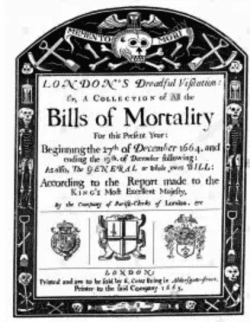
Take the simple assertion (to found in in most books pupils will come across), that only 6 deaths resulted from the blaze.
- Do the pupils find this surprising , given the very large number of houses burnt down?
- So is it possible that only 6 died (pupils might think that most were able to escape)?
- Is it likely (given the spread and duration of the fire and the chaotic fire fighting methods)?
- What is the evidence that only 6 died?
- Can we trust that evidence?
Some pupils might like to know, from you, that:
a. there was a four week gap after the Great Fire before the so-called Bills of Mortality were published.
Unfortunately one of the few gaps in the publishing run of the weekly Bills of Mortality occurs at the time of the Great Fire.( For more detail see end of page. While the clerks were able to remove many of their possessions and papers they did not have time or resources to save their heavy and cumbersome printing press. The press was sacrificed to the advancing flames on the night of Sunday 2 September So the weekly Bills provide no record of those who may have died as a direct result of the Fire.
So the weekly Bills provide no record of those who may have died as a direct result of the Fire.
- In parish records there is an increase in the number of deaths immediately after the Fire, not recorded in the Bills of Mortality
- Written records from diarists like John Evelyn talk of a foul smell caused by burning bodies. Perhaps bodies were disposed of before being recorded?
- It was difficult to recognize badly burned bodies (be careful: this may be for you only. Think of 9/11)
- It was difficult to keep accurate records at the time
Walter George Bell in his account of the Fire, first published in 1923, estimated no more than six had been burnt. He provided details for four of these victims, drawn from various sources. These included the maid servant of Farriner, the baker, who was left behind in Pudding Lane; an old women who was burnt while sheltering in the shadow of the walls of St Paul’s; Paul Lowell an 80 year old watchmaker who refused to leave his house in Shoe Lane; and an old man who also perished at St Paul’s and whom Samuel Pepys informs us died when he returned to collect a blanket he had left there.
In fact at the time there was a general belief that despite the devastation no-one had died in the Fire, a view that was communicated readily as a form of English miracle. So we, 350 years later, have a broad consensus that only a handful of Londoners died during the four days of the Great Fire in September 1666; but in April 1704 poor Widow Mullins might not have agreed with such an estimation as she accepted from the Commissioners for the Rebuilding of St Paul’s the sum of ‘£5 for her present subsistence’ following the death of her husband, a labourer lately killed on the cathedral works.
Find out more about teaching The Great Fire at key stage 1 here >>








